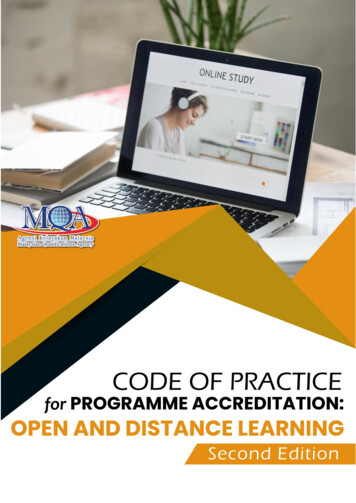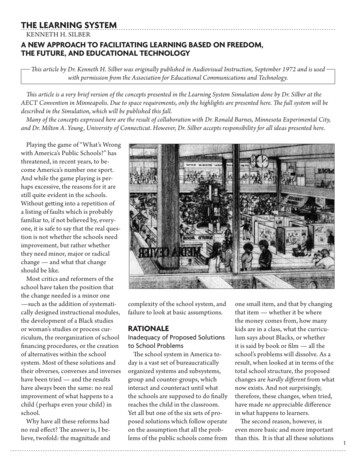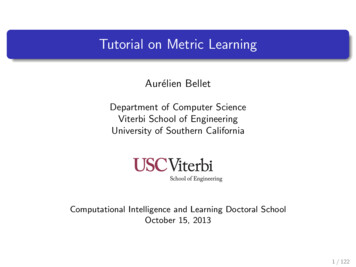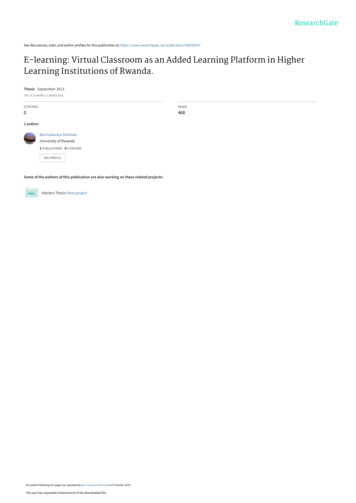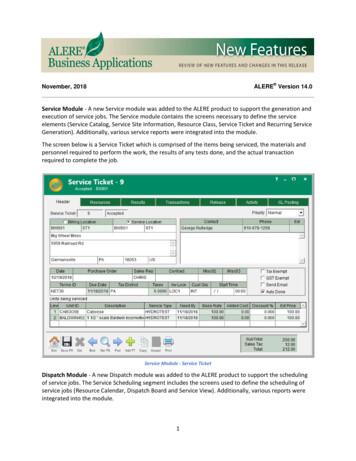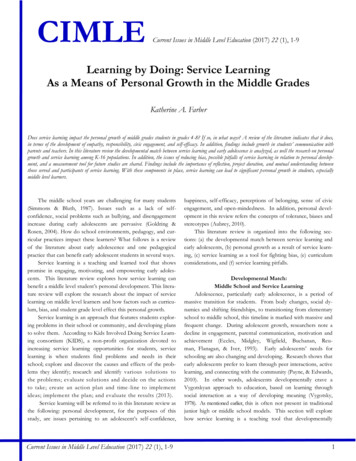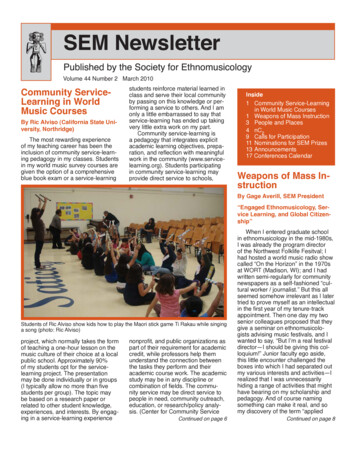
Transcription
Volume 44 Number 2 March 2010Community ServiceLearning in WorldMusic CoursesBy Ric Alviso (California State University, Northridge)The most rewarding experienceof my teaching career has been theinclusion of community service-learning pedagogy in my classes. Studentsin my world music survey courses aregiven the option of a comprehensiveblue book exam or a service-learningstudents reinforce material learned inclass and serve their local communityby passing on this knowledge or performing a service to others. And I amonly a little embarrassed to say thatservice-learning has ended up takingvery little extra work on my part.Community service-learning isa pedagogy that integrates explicitacademic learning objectives, preparation, and reflection with meaningfulwork in the community (www.servicelearning.org). Students participatingin community service-learning mayprovide direct service to schools,Inside1 Community Service-Learningin World Music Courses1 Weapons of Mass Instruction3 People and Places4 nC29 Calls for Participation11 Nominations for SEM Prizes13 Announcements17 Conferences CalendarWeapons of Mass InstructionBy Gage Averill, SEM President“Engaged Ethnomusicology, Service Learning, and Global Citizenship”Students of Ric Alviso show kids how to play the Maori stick game Ti Rakau while singinga song (photo: Ric Alviso)project, which normally takes the formof teaching a one-hour lesson on themusic culture of their choice at a localpublic school. Approximately 90%of my students opt for the servicelearning project. The presentationmay be done individually or in groups(I typically allow no more than fivestudents per group). The topic maybe based on a research paper orrelated to other student knowledge,experiences, and interests. By engaging in a service-learning experiencenonprofit, and public organizations aspart of their requirement for academiccredit, while professors help themunderstand the connection betweenthe tasks they perform and theiracademic course work. The academicstudy may be in any discipline orcombination of fields. The community service may be direct service topeople in need, community outreach,education, or research/policy analysis. (Center for Community ServiceContinued on page 6When I entered graduate schoolin ethnomusicology in the mid-1980s,I was already the program directorof the Northwest Folklife Fesitval; Ihad hosted a world music radio showcalled “On the Horizon” in the 1970sat WORT (Madison, WI); and I hadwritten semi-regularly for communitynewspapers as a self-fashioned “cultural worker / journalist.” But this allseemed somehow irrelevant as I latertried to prove myself as an intellectualin the first year of my tenure-trackappointment. Then one day my twosenior colleagues proposed that theygive a seminar on ethnomusicologists advising music festivals, and Iwanted to say, “But I’m a real festivaldirector—I should be giving this colloquium!” Junior faculty ego aside,this little encounter challenged theboxes into which I had separated outmy various interests and activities—Irealized that I was unnecessarilyhiding a range of activities that mighthave bearing on my scholarship andpedagogy. And of course namingsomething can make it real, and somy discovery of the term “appliedContinued on page 8
Internet ResourcesThe SEM Websitehttp://www.ethnomusicology.orgThe SEM Discussion List: SEM-LTo subscribe, send email messageto: LISTSERV@LISTSERV.INDIANA.EDU. Leave subject line blank. Typethe following message: SUBSCRIBESEM-L yourfirstname yourlastname.SEM Applied Ethnomusicology Sectionhttp://www.appliedethnomusicology.orgSEM Chapter WebsitesMid Atlantic Chapterhttp://www.macsem.orgMid-West Chapterhttp://sem-midwest.osu.edu/Niagara EM/NiagaraSEM.htmNortheast Chapterhttp://www.necsem.orgNorthwest Chapter w.htmlSoutheast-Caribbean Chapterhttp://otto.cmr.fsu.edu/ cma/SEM/SEMSEC02.htm/Southern California & Hawai i .htmlSouthern Plains SEMsouthernplains.htmlSouthwest Chapterhttp://www.u.arizona.edu/ sturman/SEMSW/SEMSWhome.htmlEthnomusicology SitesAmerican Folklife Centerhttp://lcweb.loc.gov/folklife/British Forum for Ethnomusicologyhttp://www.bfe.org.ukBritish Library Sound ArchiveWorld and Traditional Music .bl.ukChristian Musicological Society of Indiahttp://www.thecmsindia.orgEthnomusicology OnLine (EOL)http://umbc.edu/eol (home site)International Council for n Musicology gyMusic & p://research.umbc.edu/eol/MA/index.htmSmithsonian Institution //www.folkways.si.eduSociety for American Musicwww.American-Music.orgUCLA Ethnomusicology rsity of Washington Ethnomusicology .php?page archivesSEM Newsletter GuidelinesGuidelines for Contributors Send articles to the editor by email or on a disk with a paper copy. Microsoft Word is preferable, but other Macintosh or IBM-compatible software isacceptable. Identify the software you use. Please send faxes or paper copies without a disk only as a last resort.Advertising RatesCopy DeadlinesRates for Camera Ready CopyMarch issue.January 15Full Page 200May issue. March 152/3 Page 145September issue. July 151/2 Page 110January issue.November 151/3 Page 601/6 Page 40Additional charges apply to non-camera-ready materials. SEM NewsletterThe Society for Ethnomusicology and the SEM NewsletterEditor, SEM NewsletterHenry SpillerDepartment of MusicUniversity of CaliforniaOne Shields AvenueDavis, CA 95616, USA(Tel) 530.757.5791 (Fax) 530.752.0983(Email) hjspiller@ucdavis.eduThe SEM NewsletterThe SEM Newsletter is a vehicle for exchange of ideas, news, and information amongthe Society’s members. Readers’ contributionsare welcome and should be sent to the editor.See the guidelines for contributions on this page.The SEM Newsletter is published four timesannually, in January, March, May, and September, by the Society for Ethnomusicology. Inc., andis distributed free to members of the Society.Back issues, 1981-present [Vols. 14-18(1981-84), 3 times a year; Vols. 19-32 (19851998), 4 times a year] are available and may beordered at 2 each. Add 2.50/order for postage.Address changes, orders for back issues ofthe SEM Newsletter, and all other non-editorialinquiries should be sent to the Business Office,Society for Ethnomusicology, Indiana University,Morrison Hall 005, 1165 East 3rd Street, Bloomington, IN, 47405-3700; (Tel) 812.855.6672; (Fax)812.855.6673; (Email) sem@ indiana.edu.SEM MembershipThe object of the Society for Ethnomusicology is the advancement of research and study inthe field of ethnomusicology, for which purposeall interested persons, regardless of race, ethnicity, religion, gender, sexual orientation, or physicalability are encouraged to become members. Itsaims include serving the membership and societyat large through the dissemination of knowledgeconcerning the music of the world’s peoples. TheSociety, incorporated in the United States, has aninternational membership.Members receive free copies of the journaland the newsletter and have the right to vote andparticipate in the activities of the Society. Lifemembers receive free copies of all publicationsof the Society. Institutional members receive thejournal and the newsletter.Student (full-time only) (one year). 40Individual/Emeritus (one year)income 25,000 or less. 60income 25,000- 40,000. 75income 40,000- 60,000. 85income 60,000- 80,000. 95income 80,000 and above. 105Spouse/Partner Individual (one year). 35Life membership. 1200Spouse/Partner Life. 1400Sponsored* (one year). 57Institutional membership (one year). 115Overseas postage (one year). 22*Donated membership for individuals and institutionsin soft-currency countries. Send sponsorship letter withdues ( 35) and postage (either 10 Surface rate or 25airmail) to the SEM Business Office.Ethnomusicology: Back IssuesThe Society’s journal, Ethnomusicology, iscurrently published three times a year. Back issues are available through the SEM Business Office, Indiana University, Morrison Hall 005, 1165East 3rd Street, Bloomington, IN 47405-3700;(Tel) 812.855.6672; (Fax) 812.855.6673; (Email)sem@indiana.edu.ISSN 0036-1291
People and PlacesTemple University Press has published Cathy Ragland’s new book,Música Norteña: Mexican MigrantsCreating a Nation between Nations(2009). For more information, see(website) http://www.temple.edu/tempress/titles/1957 reg.html.John Edward Hasse (Curator ofAmerican Music, Smithsonian Institution) curated an exhibition, JazzComposers: Duke Ellington and BillyStrayhorn, at the Smithsonian’s National Museum of American History,on view in spring and summer 2009.The exhibition can be seen and heardat (website) ibitions/ellington strayhorn 1.html. In a program broadcast in September, 2009,Hasse helped solve a “mystery” aboutBilly Strayhorn for PBS’s HistoryDetectives. In 2008, Hasse helpedorganize a tour to Egypt by the Smithsonian Jazz Masterworks Orchestra,under maestro David Baker, and lectured on Louis Armstrong at AmericanUniversity in Cairo and at the American Cultural Center in Alexandria.In 2009, for the State Department,Hasse lectured—on Louis Armstrongand Duke Ellington—in Addis Ababa,Ethiopia; Nairobi, Kenya; and Lusaka,Zambia.Upon his retirementin 2008, Roderic Knightgave his musical instrument collection to theOberlin Conservatoryof Music. With the aidof twenty students in aseminar in organology in2007-08, the collectionwas fully catalogued andnow may be viewed onlinein a searchable databaseat (website) www.oberlin.edu/library/digital/knight.The collection of some280 instruments coversthe world, but areas moststrongly representedare West Africa (SierraLeone and Gambia), India(North, South, tribal andfolk), and China. The collection also serves to outline a classification system devised by Knightthat retains the Hornbostel-Sachsapproach, but with major revisions.The full details of the system will beforthcoming soon.In 2009, Ryan Skinner’s children’s book, Sidikiba’s Kora Lesson(Beaver’s Pond Press, 2008), wonthe Independent Book Publishers Association Benjamin Franklin Award inthe category of multicultural litera-African xylophone from the Roderic C. Knight Musical Instrument Collection, Oberlin ght) (photo: Roderic Knight)ture. It also won a Silver Medal in theBook With Music/Theatrical categoryfrom the Moonbeam Children’s BookAwards. Sidikiba’s Kora Lesson wasalso a finalist in the 2009 MidwestBook Awards (child/young adultfiction) and the National Indie Excellence Awards (children’s fiction). Formore information, see (website) www.sidikibaskoralesson.com.In December 2009 the 10-CDboxed set with book called AlanLomax in Haiti, 1936-37—compiled,edited and annotated by Gage Averill—was released by Harte Records.Additional information about the se,which has been covered by The NewYorker, The Wall Street Journal, TheNew York Times, the BBC, CBC,The Village Voice, and many otheroutlets, can be found at (website)http://thehaitibox.blogspot.com/. Therepatriation of the collection in Haitiwas declared an outstanding projectof the Clinton Global Initiative for Haitiin 2010 in partnership with the GreenFamily Foundation.David Harnish (Bowling GreenState University) conducted researchin Indonesia during Fall, 2009, andwill teach on the Semester at Seaship in the Spring of 2010.Since 2005, Mauricio Martinezhas been working on two big projects:the Web Encyclopedia of JapanesePerforming Arts in Spanish (www.japonartesescenicas.org) and the WebEncyclopedia of Korean PerformingContinued on page 14SEM Newsletter
What intersubjective worlds do we create in conversation? How receptive are we to the new truths these worlds reveal? Even when theychallenge canonic belief, that ‘paramount reality’ in which we find “epistemic if not ontological security”1? Fieldwork is our methodology forclimbing out of the allegorical cave. But discursive conventions, unreflexively performed social roles, and expectations cast on others threatenour percipience, while the forms we seek pass in the purlieus of our reduced reality.The prison may be a paragon of settings for inquiries into reality: a universe unto itself with conditions that index the outside worldto both preserve and negate it, the tenebrous solitude of the devalued individual peopling a private inner world, doubts about moral foundationsin light of natural chance and judicial caprice. The need for humanizing, reciprocal recognition is great, while the vulnerability of yearningand the perceived void between histories heighten the possibility of misrecognition. The tunnels we dig towards one another require heart. Andtools. In Ben Harbert’s essay we find one possible toolkit. —Jesse Samba Wheeler1.Crapanzano, Vincent. 2006. “The Scene: Shadowing the Real.” Anthropological Theory 6(4):387-405, p. 389. Reading “Little Boy Blue”:Autopsychomusicology in a Maximum Security Prison by Ben HarbertCalifornia State Prison (New Folsom), Sacramento, CA, USA, August 2OO9My penchant for transcription and formal analysis does not always make for theeasiest conversation. Neither does being told about a stranger’s childhood sexualabuse. I am in New Folsom State Prison’s overly organized music room, filled withguitars, drums, and horns locked away in loft cages. A dated poster of Jimi Hendrixgraces a cinderblock wall. I’m waiting to ask Bill Martin (not his real name), aconvicted murderer serving a life sentence, about “composer’s intent” in relation toa song he wrote.The night before, Jim Carlson, New Folsom’s arts facilitator, had played me arecording of Bill’s song “Little Boy Blue,” which introspectively grapples with having been sexually abused as a child. I heard a parallel in the musical structure.Jim was struck by the atypical lyrical reflection given how guarded inmate conversation can be. Little boy in the window,Let you come out and play.Mama says that she loves you.She don’t love you today.Tonight you stay at the neighbor’s,You know just what that means.They know you don’t like it,No point in making a scene.Little scars on your body,Little scars on your mind.Little secrets you’re keeping,Get bigger every time.Now them hands on your body,Can’t hear you when you cry.If you try to tell Momma,Momma says it’s a lie.Ooh, ooh, what you going to do, boy?Ooh, ooh, little boy blue.Ooh, ooh, well, what you going to do, boy?Ooh, ooh . . .SEM Newsletter
Accompanying himself with a resonant 12-string guitar, Bill vacillates betweenE7 and A chords. An awkward blues-inflected turnaround with a few non-chord tonespunctuates the riff (see transcription), saving it from Donovan’s “Season of theWitch.” The chorus rises to a B minor chord, neutering the expected D# of a B7, before descending to the A. Reading the music in psychological context, a few thingsstruck me as extensions of the sentiment: a lack of resolution in the chord selection, the uncomfortable return of the b5 in the turnaround, and the octave-displacedlast note of the turnaround (somewhat saved by the fact that a 12-string doublesstrings in octaves on its lowest four strings, reflected in the transcription). Tome, the Bb represents the line, “Little secrets you’re keeping, get bigger everytime.” The lack of resolution resonates with “If you try to tell Momma, Momma saysit’s a lie.” How much am I projecting on Bill’s song? “You can ask him tomorrow,”Jim said.My main work this summer was to collect documents for a UCLA archive that I ambuilding in California’s Arts In Corrections program with the support of Dean ChrisWaterman and the GRAMMY Foundation. This was a salvage mission given that California is suffering severe fiscal problems at a time when the remaining prison artsfacilitators are retiring. That’s what brought me to New Folsom, a stark maximumsecurity facility in Sacramento County about to be starker given the massive projected cuts to education and rehabilitation staff. Continued on p. 15SEM Newsletter
Community ServiceLearningalong with a map coloring activity, description of important musical instruments along with an activity to makeand decorate a set of claves, as wellas learning to play the son claverhythm and learning simple dancesteps. There are also many lessonplans for world music on the web tohelp give students ideas.I suggest that students choose amusical style or music culture withwhich they already have some experience. Some students choose one ofthe world music ensembles that weoffer at Cal State Northridge such asJapanese taiko drumming, West African drumming/dance, or steel drum.The added benefit of going this direction is that the students may borrowthe university’s instruments for theirpresentation. And those presentationswhere students can have communitycontinued from page 1Learning 2000) Research shows that“participation in education-relatedservice enhances the student’s college grade point average, generalknowledge, knowledge of a field ofdiscipline, and aspirations for advanced degrees and is also associated with increased time devoted tohomework and studying ” (Astin andSax 1998:257).I provide students with a samplelesson plan (see Figure 1). I askstudents to limit content to a few keypoints and focus more on participation and fun. For instance, a lessonon Cuban music might include a fewminutes on history and geographyService-Learning Sample Lesson PlanPlease use the following format for your lesson plan.****Name(s)Grade: (e.g. First grade)******TITLE OF LESSON(e.g. Viva Mexico!)**CourseTime: (e.g. 1 hour with 10-15 minutes of transition time as a buffer)Objective: (e.g. A) Students will gain an appreciation for the music and culture ofMexico. B) Students will be able to sing a simple Spanish song. C) Students will beintroduced to the dance “La Raspa.”)Materials: (e.g.m\, Guitar, maracas, globe, "La Raspa CD," pictures of trumpets, violins,and celebrations)Procedure:1) (5 min.- Mary) Introduce ourselves. Introduce the country of Mexico by bringing outthe globe. Show them where it is in relation to the United States. Then show them ona map. Explain that it is a different country so they have a different culture. Whatdoes that mean?a. Language, music, celebrations, food.b. Mexican culture is very festive. They have fiestas (celebrations) almost every dayin some city or town.c. Fiestas. Discuss food, music, clothing and dance. Show pictures.2) (20 min.- John, Ted, Mary) Show them pictures of instruments. Talk about thetrumpet (loud) and violin (soft) and then bring out the guitar and maracas. Tell themthat they will get to make their own maracas. Students will move to their desks.a. They will each get a template on card stock to color, and when they are done,Mary will help them staple it together with beans inside.b. While they are doing this, John and Ted will go around and let the kids play theguitar and maracas.3) (15 min. Victoria, John, Ted) “One of the songs they sing in Mexico is called “LasMañanitas.” It is a song that people sing at fiestas when there is a birthday.” John willplay the guitar while they play along with their maracas. Victoria will sing while Tedand Mary helps the kids play on the beat.4) (15 min. Mary, John, Ted, Victoria) Students will move outside and Mary will teachthe dance steps to “La Raspa” while Ted, John and Victoria help and play along. Halfthe kids will play their maracas while the other half dance and then the kids will tradeplaces.5) (5 min. Victoria) Closure: “What did we learn about the music of Mexico?” (Pass outcandy and say goodbye!)Figure 1: Service-Learning Sample Lesson Plan SEM Newslettermembers get their hands on actual instruments are typically a big success.In addition I have students fill outand sign a Service-Learning Checklist(see Figure 2) that assures that theyare fully organized for their schoolvisit and understanding the roles andresponsibilities. Upon approval ofthese forms I give the student(s) aService-Learning Grade Sheet (seeFigure 3), which will be taken to theschool and filled out by the on-siteteacher at the time of the presentation. Evaluation will be based oninteraction with class, mastery of material, and teaching effectiveness. Theschool presentations are coordinateddirectly between my students and thelocal school teachers/administrators.I also provide contacts when requested. Although public schools arethe most popular sites, my studentshave also performed service-learningprojects at senior centers, centers foradults with disabilities, juvenile detention centers, and other non-profitprograms.The teachers and administrators are normally thrilled to have mystudents come to their schools. I don’tapprove a group unless I am confident in them and their level of preparation. I will often have the groupdo a run-through of key sections oftheir presentation for me if I have anyreservations or questions about theirability to provide an effective andengaging lesson. Thus it is rare forme to see anything but glowing praisefrom the teachers or administratorson the Grade Sheet. The most common problems I have encountered inoverseeing the process include thetypical personal dynamics associatedwith any group project and guidingstudents to create lesson plans haveplenty of participation and limited“talking heads” style lecture.The completed Service-LearningGrade Sheet along with a ReflectionPaper (worth 15% of the grade) aredue within a week of the presentation. In the Reflection Paper studentsdescribe their experience in theschool, self-assess their effectivenessin teaching the material to children,and indicate what they learned fromthe experience and how the experience has affected their perspectiveon music and culture.
SERVICE-LEARNING AGREEMENT CHECKLISTPresentation Topic:Names of group members:Contact phone numbers for group leader(s):Presentation Date:School:School Contact Person:Phone:1) We have contacted the school to confirm our presentation date, time, size ofclass, age/grade, audio-visual needs, and any other information needed to provide aneffective lesson.2) We have discussed with the teacher/contact person our expectations of theteacher's role during our presentation.3) We have directions and transportation to the site.4) We have organized our presentation so that it is informative, creative, andinteractive.5) We understand that if we cannot make it to our presentation we will call ourschool and inform them. We also understand that last-minute cancellations may lead tothe forfeit of the service learning option for the course final.6) We have provided our professor and the school teacher with a lesson plan of ourpresentation which clearly identifies the responsibilities of our group members ONEWEEK IN ADVANCE OF OUR PRESENTATION.7) We have provided professor with a copy of this checklist/agreement.8) We understand that upon receipt and approval of this agreement and a lessonplan, our professor will provide us with a copy of the Service-Learning Rating Sheet togive to our teacher. We will not receive a grade unless this rating sheet is filled out by theteacher at the time of our presentation and given back to professor.Signatures of group membersDate:Figure 2: Service-Learning Agreement ChecklistPerhaps the highlight of mysemester is reading the reflection papers students write after their servicelearning experience. Here are a fewsamples:“My service-learning presentation at Calahan School wasone of the most rewardingexperiences I’ve ever had.”“Doing my final this way taughtme more than I could havepossibly learned by reading abook.”“Service-learning was a greatexperience for me. I was thinking about making a career outof teaching. This made merealize that teaching is what Iwant to do.”“Even though I was apprehensive at first about teachingmusic and culture in a classroom, afterward it felt great tohave opened the eyes of thesechildren to the world throughmusic.”Additional benefits to studentsinclude improved leadership abilities,greater sense of civic responsibility,and increased sensitivity to diversity.Student conducts an instrument petting zoo at a world musicfestival in Encino, October 2009, as part of his communityservice-learning project (photo: Ric Alviso)For me as a teacherthe benefits includeSERVICE-LEARNING GRADE SHEETsatisfaction of impactingNames of presenters: Mary Smith, John Doestudents and creatingRater: Please rate the groups on the following areas by circling the best response.a memorable experi1. Mastery of MaterialPOORFAIRGOODEXCELLENTence, providing music2. Teaching effectivenessPOORFAIRGOODEXCELLENTto schools with limited3. Interaction with classPOORFAIRGOODEXCELLENTfunding, providing theDid all the above named students participate? (YES/NO)school children andComments:community with exposure to various culturesand fostering a strongerconnection betweenmy university and thecommunity. I know thatRater's namewhat I have done in myPhone Number: Date:Thank you!!!classes only scratchesthe surface in terms ofFigure 3: Service-Learning Gade Sheetthe many ways community service-learning pedagogy canService-Learning Workshop.”be combined with ethnomusicology.California State University,It is my hope that this short articleNorthridge.inspires and challenges others to gettheir students involved in meaningNational Service-Learningful community work as part of theirClearinghouse. Accessedacademic experience.January 14, 2010. http://www.servicelearning.org/ReferencesSatin, A. and Sax, L. 1998. “Howundergraduates are affected byCenter for Community Serviceservice participation.” Journal ofLearning. 2000. “Fall 2000College Student Development.Faculty Development Grant39(3), 251-262.SEM Newsletter
Weapons of Mass Instructioncontinued from page 1ethnomusicology” around that sametime had a kind of revelatory powerfor me. My work in Haiti brought morefestivals, years of music journalismfor The Beat, and election monitoring,expert witness testimony, consultationfor philanthropic agencies, and othersuch “tangents,” but with the new (forme) “applied” rubric, my various andsundry outside activities were broughtinside, finding a place on my CVand in my teaching and publishing,becoming a part of a larger ethnomusicological whole for me.My preferred nomenclature variedover the years: “applied” carried connotations from the natural sciences,where applied sciences (e.g., appliedmaterials science) takes work doneby others in the lab and providespractical applications. “Public ethnomusicology” appealed, although itseemed a little too allied to a Habermasian notion of the “public sphere,”as did “advocacy ethnomusicology,”but the latter struck me as too rootedin political instrumentality. All threefelt too narrow when applied to thefull range of activities I hoped toincorporate, so in the end, I settledon “engaged ethnomusicology” with afaint echo of Paris ‘68 and the call toan engaged intelligentsia.When I attended early gatheringsethnomusicologists working in similarareas, I found that applied ethnomusicology was often framed in thecontext of alternative career choicesto academia, and didn’t yet ring witha broad obligation for ethnomusicologists (whether inside or outside ofacademic institutions) to share theirexperiences, training, and understanding widely. And when scholarsin ethnomusicology did write aboutadvocacy, the ethical imperative forintervention in the public sector wastypically linked to a need for reciprocity stemming from the fieldworkrelationship, i.e., that the servicesprovided to scholars by informants,collaborators, or consultants (servicesthat vastly inflate the scholar’s reputation, earning potential, and security)mandate reciprocal gestures. Relationships of this nature do requirereciprocity, but the moral and ethical SEM Newsletterunderpinnings of engaged ethnomusicology, I felt, were much morecomplex than simple reciprocity.There is a long history of advocacy within ethnomusicology andallied disciplines. Anthropologists andethnomusicologists have inherited arich legacy of activist work from theearly days of the Bureau of AmericanEthnology, to the New Deal’s WorksProgress Administration and FederalWriter’s Project, when B.A. Botkinand Alan Lomax and others dedicatedthemselves to the service of culturalpluralism and community empowerment and against a narrow elitist construction of “culture.” We can point toa vast infrastructure of projects, agencies, institutions, archives, museums,and organizations that are devoted tothese principles and that reflect thesuccess of these earlier generationsof activist intellectuals. Anthropologists and ethnomusicologists fromMelville and Frances Herskovits toMargaret Meade to John Blacking,Lila Abu-Lughod, Steven Feld, anda host of others have weighed in aspublic intellectuals on issues of race,Western child-rearing and educational practices, indigenous rights,and gender equity. Ethnographershave contributed in their own ways tothe slow (however contested) triumphof ideas of multicultural democracy,global decolonization, the rights ofindigenous peoples, and the right ofcultural self-determination. So let’savoid the ahistoricist notion that engaged ethno
sonian Jazz Masterworks Orchestra, under maestro David Baker, and lec-tured on Louis Armstrong at American University in Cairo and at the Ameri-can Cultural Center in Alexandria. In 2009, for the State Department, Hasse lectured—on Louis Armstrong and Duke Ellington—in Addis Ababa, Ethiopia; Nairobi, Kenya; and Lusaka, Zambia.



